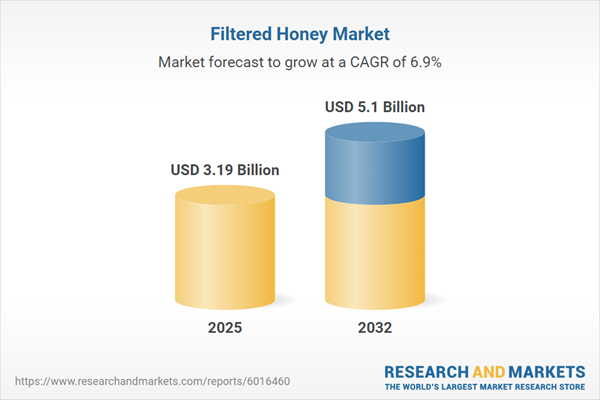Speak directly to the analyst to clarify any post sales queries you may have.
The filtered honey market is quickly transforming as business leaders respond to changes in buyer preferences, sustainability pressures, and technology developments. Senior decision-makers must adapt sourcing, product, and channel strategies to maintain resilience and capitalize on new growth opportunities.
Market Snapshot: Filtered Honey Market Size and Growth Outlook
The filtered honey market reached USD 2.98 billion in 2024, with projections indicating an increase to USD 3.19 billion by 2025 and a compound annual growth rate (CAGR) of 6.92%. By 2032, the market is expected to approach USD 5.10 billion. Ongoing growth is fueled by consistent demand from food, beverage, and wellness sectors, while advances in filtration techniques and an emphasis on product purity enable brands to pursue premium positioning and specialized offerings. These shifts allow organizations to diversify portfolios and respond to nuanced buyer expectations.
Scope & Segmentation of the Filtered Honey Market
This report delivers a comprehensive segmentation of the filtered honey market to aid decision-makers in targeted strategy development across sectors and regions.
- Product Types: Portfolio options include creamed, organic, pasteurized, and raw filtered honey, meeting both broad consumer needs and specific dietary requirements to support product differentiation.
- Floral Sources: Monofloral varieties such as Acacia, Clover, and Manuka, as well as blended alternatives, offer opportunities for brand differentiation by flavor profile, source authenticity, and targeted applications.
- Packaging Formats: Choices range from bulk industrial drums and glass jars to recyclable squeeze bottles and single-serve sachets, balancing convenience, sustainability, and scale for both producers and buyers.
- Distribution Channels: Supermarkets, hypermarkets, online platforms, specialty retailers, and convenience outlets create omnichannel accessibility and segment-specific approaches for improved market reach.
- Applications: Uses extend to table sweeteners, food ingredients, cosmetics, functional foods, and pharmaceuticals, emphasizing versatility and value for consumer and commercial segments alike.
- Regional Coverage: The Americas, EMEA, and Asia-Pacific each present distinct regulatory environments and consumption patterns, requiring tailored go-to-market and compliance strategies.
- Industry Leaders: Key companies profiled include Dabur India Limited, Comvita Limited, Capilano Honey Limited, Kerry Group plc, B&G Foods, The Hain Celestial Group, Manuka Health New Zealand, Dutch Gold Honey, Nature Nate's, and Rowse Honey.
Key Takeaways: Strategic Insights for Senior Decision-Makers
- Emerging filtration technologies preserve intrinsic nutrients and enzymes, enabling producers to deliver authentic products suited for upscale positioning in the filtered honey category.
- Growth in premium and differentiated honey types is broadening applications in culinary, nutraceutical, and personal care sectors, unlocking revenue potential outside core retail channels.
- Incorporation of blockchain and digital labeling solutions enhances traceability and consumer trust throughout sourcing and distribution networks.
- Adoption of recyclable and reusable packaging solutions aligns with evolving expectations among buyers, strengthening brand competitiveness and sustainability credentials.
- Expansion of e-commerce delivers direct-to-consumer access, supports launches of niche offerings, and facilitates precise market segmentation driven by shopper analytics.
- Specialty variants such as creamed and unique floral honey options appeal to food manufacturers and services seeking tailored ingredient benefits and enhanced product profiles.
Tariff Impact: Responding to Shifting Global Trade Policies
Changes in U.S. tariffs on filtered honey imports have shifted global trade flows. As a response, companies are increasing local sourcing and expanding regional processing operations to maintain cost efficiency and reliable supply. Adjusting procurement, logistics networks, and partnering models supports resilience, mitigates regulatory risk, and helps ensure uninterrupted market access in an evolving trade environment.
Methodology & Data Sources
This filtered honey market analysis combines over eighty primary interviews with producers, suppliers, and key stakeholders. Secondary research draws from official trade databases and regulatory reviews. A structured approach integrates quantitative supply chain mapping and expert triangulation, supporting credible forecasting and scenario-based market modeling.
Why This Report Matters
- Enables leadership teams to optimize supply channel selection, refine product strategies, and pursue attractive growth opportunities specific to the filtered honey market.
- Clarifies the operational impact of adopting advanced technology, evolving packaging trends, and regulatory shifts, supporting evidence-based risk management.
- Informs agile planning by providing actionable analysis on innovation, supplier realignment, and new commercialization pathways in competitive regions.
Conclusion
This report equips senior leaders with actionable insights on segmentation, technology integration, and evolving trade dynamics in the filtered honey market, supporting resilient decision-making in competitive global contexts.
Additional Product Information:
- Purchase of this report includes 1 year online access with quarterly updates.
- This report can be updated on request. Please contact our Customer Experience team using the Ask a Question widget on our website.
Table of Contents
3. Executive Summary
4. Market Overview
7. Cumulative Impact of Artificial Intelligence 2025
Companies Mentioned
The companies profiled in this Filtered Honey market report include:- Dabur India Limited
- Comvita Limited
- Capilano Honey Limited
- Kerry Group PLC
- B&G Foods, Inc.
- The Hain Celestial Group, Inc.
- Manuka Health New Zealand Limited
- Dutch Gold Honey Co.
- Nature Nate's LLC
- Rowse Honey Limited
Table Information
| Report Attribute | Details |
|---|---|
| No. of Pages | 194 |
| Published | November 2025 |
| Forecast Period | 2025 - 2032 |
| Estimated Market Value ( USD | $ 3.19 Billion |
| Forecasted Market Value ( USD | $ 5.1 Billion |
| Compound Annual Growth Rate | 6.9% |
| Regions Covered | Global |
| No. of Companies Mentioned | 11 |









